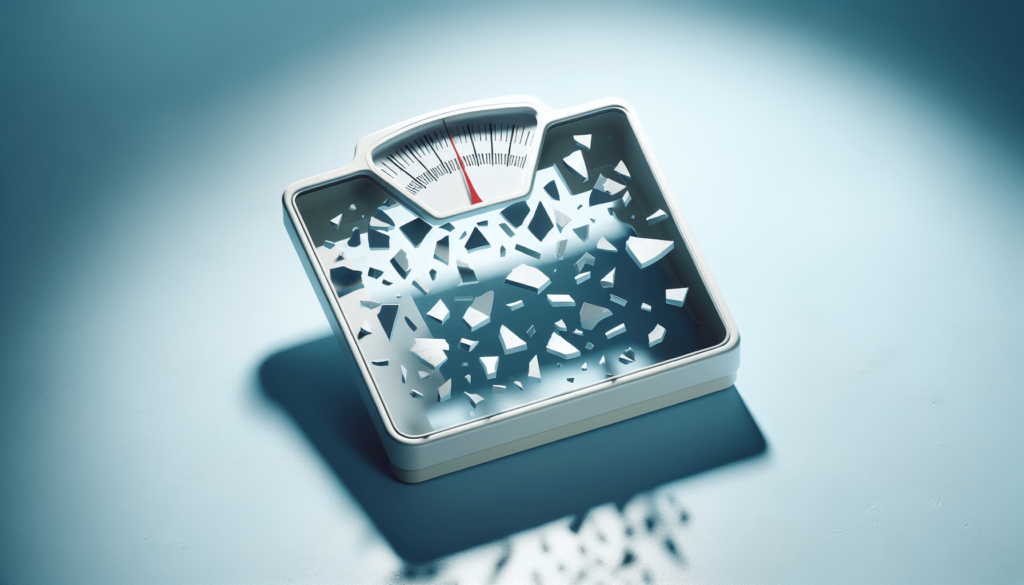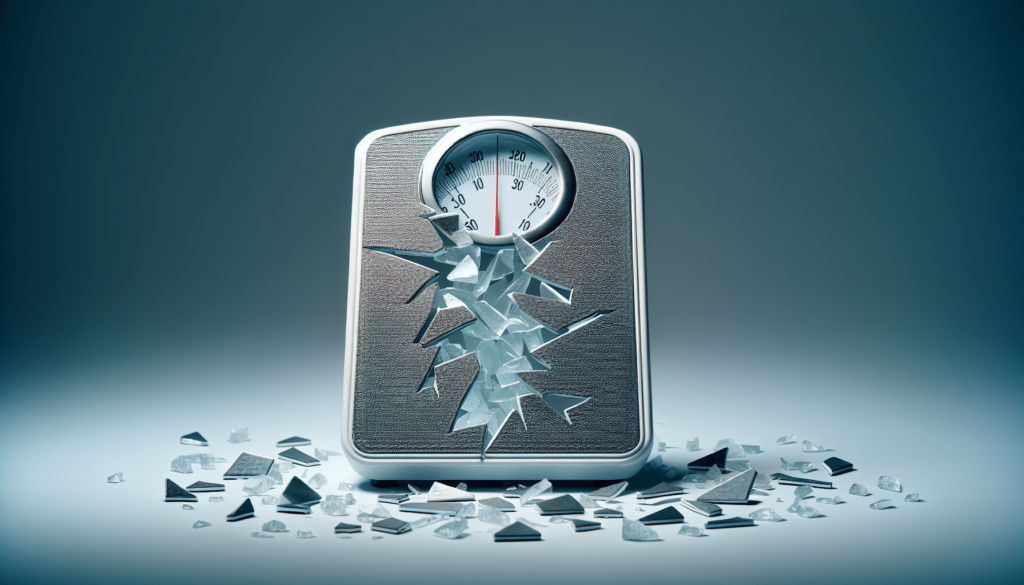The post 10 Common Myths About Weight Loss Debunked appeared first on Akron Weight Loss Programs.
]]>Weight loss is often surrounded by misinformation that can lead to frustration and confusion. In “10 Common Myths About Weight Loss Debunked,” you’ll discover the truth behind some of the most widespread myths that might be hindering your progress. From the misconception that carbs are your enemy to the mistaken belief that you have to starve to shed pounds, this article clarifies these myths with facts and easy-to-understand explanations. Get ready to reshape your approach to weight loss with accurate information that supports a healthier lifestyle. Have you ever found yourself drowning in a sea of conflicting advice when it comes to weight loss? You’re not alone. With so much information out there, it’s easy to become overwhelmed and susceptible to myths. It’s about time we set the record straight. Here, we’ll debunk 10 common weight loss myths to help you navigate your journey more effectively and healthily.

Get The Truth About Weight Loss
Myth #1: You Need to Starve Yourself to Lose Weight
It might seem logical that eating less will result in weight loss, but starving yourself is neither effective nor sustainable. The importance of balanced nutrition cannot be overstated. When you deprive your body of essential nutrients, it can lead to muscle loss instead of fat loss and even slow down your metabolism.
The Concept of Caloric Balance
Understanding how to balance caloric intake is crucial. Here’s a simple guide:
| Type of Caloric Balance | Definition | Impact on Weight |
|---|---|---|
| Caloric Surplus | Eating more calories than you burn | Weight Gain |
| Caloric Deficit | Eating fewer calories than you burn | Weight Loss |
| Maintenance | Eating the same amount of calories as you burn | Stable Weight |
Instead of starvation, you should aim for a moderate caloric deficit, which supports sustainable weight loss and keeps your body well-nourished.
Myth #2: All Calories Are Created Equal
Not all calories deliver the same nutritional benefits, and the source of your calories matters immensely. For instance, calories from a candy bar loaded with sugar and fats behave differently in your body compared to calories from a piece of grilled chicken.
The Role of Macronutrients
Macronutrients like proteins, fats, and carbohydrates play distinctive roles. To illustrate:
| Macronutrient | Function | Food Sources |
|---|---|---|
| Protein | Muscle repair and growth | Chicken, fish, beans |
| Fat | Hormone production, energy storage | Nuts, avocado, olive oil |
| Carbohydrate | Primary energy source | Fruits, vegetables, whole grains |
A balanced diet rich in various macronutrients supports not just weight loss but overall health.
Myth #3: Carbs Are Your Enemy
Carbohydrates have taken a lot of heat over the past decades, often getting labeled as diet wreckers. However, not all carbs are harmful.
Good Carbs vs. Bad Carbs
Good carbs, also known as complex carbohydrates, are your friends:
| Good Carbs | Bad Carbs |
|---|---|
| Whole grains | White bread |
| Vegetables | Sugary snacks |
| Fruits | Soda |
Complex carbohydrates like those found in fruits, vegetables, and whole grains provide sustained energy and essential nutrients. The key is to opt for fiber-rich, nutrient-dense carbs over refined, sugary ones.
Myth #4: Fat Makes You Fat
Dietary fats often get a bad reputation, but the relationship between fat consumption and body fat isn’t that straightforward.
Types of Fats
Here’s a look at different types of fats and their impacts:
| Type | Source | Health Impact |
|---|---|---|
| Saturated Fat | Butter, red meat | Can raise cholesterol levels |
| Unsaturated Fat | Olive oil, fish | Supports heart health, essential for brain function |
| Trans Fat | Packaged snacks, margarine | Increases risk of heart disease |
Healthy fats found in avocados, nuts, and olive oil play critical roles in body processes, from absorbing vitamins to producing hormones. It’s all about choosing the right kinds of fats and consuming them in moderation.

Myth #5: Exercise Allows You to Eat Anything
Exercise is crucial for a healthy lifestyle, but it doesn’t give you a free pass to overeat.
Calories In vs. Calories Out
To maintain a healthy weight, you need to balance the calories you consume with the calories you burn. Here’s why:
| Activity | Calories Burned (Per Hour) | Equivalent Food Item |
|---|---|---|
| Running (6 mph) | 600 | 1 Burger |
| Swimming | 500 | 2 Slices of Pizza |
| Yoga | 200 | 1 Snack Bar |
While exercise does burn calories, it’s often not enough to offset large quantities of high-calorie foods. A balanced approach combining mindful eating with physical activity is the best route for sustainable weight loss.
Myth #6: Weight Loss Supplements are Magic Pills
Weight loss supplements often promise quick fixes, but their effectiveness is questionable.
The Science Behind Supplements
While some supplements can aid in weight loss, they often don’t replace the need for a balanced diet and exercise. Key points to consider include:
| Supplement Type | Effectiveness | Risks |
|---|---|---|
| Appetite Suppressants | Limited but can help with portion control | Side effects like increased heart rate |
| Fat Burners | Often caffeine-based, increases metabolism slightly | Can cause jitters, insomnia |
| Meal Replacements | Can be effective short-term | Doesn’t teach sustainable habits |
Always consult a healthcare provider before taking any supplements. Relying solely on them can lead to nutrient deficiencies and other health issues.
Myth #7: Muscle Turns to Fat When You Stop Exercising
Muscle and fat are entirely different tissues; one doesn’t transform into the other.
Understanding Body Composition
What actually happens when you stop exercising?
- Muscle Atrophy: You lose muscle mass due to lack of use.
- Fat Accumulation: If caloric intake exceeds expenditure, fat stores will increase.
It’s not about muscles converting into fat but losing muscle mass while possibly gaining fat. Maintaining some level of physical activity is essential to keep your body balanced.
Myth #8: Eating Late at Night Causes Weight Gain
Eating late per se doesn’t cause weight gain; it’s more about what and how much you’re eating.
Timing vs. Quality
Several key points:
| Eating Scenario | Impact |
|---|---|
| Late but Small/Balanced Meal | Generally Neutral |
| Late and Heavy/High-Calorie Meal | Can lead to weight gain if it exceeds daily caloric needs |
According to studies, the total number of calories you consume matters more than the timing. If you’re hungry late at night, opt for lighter, nutrient-dense snacks like yogurt or fruits.
Myth #9: You Can Target Fat Loss to Specific Body Parts
Spot reduction, the idea that you can lose fat in a specific area by exercising that part of your body, is a common misconception.
The Truth About Fat Loss
Your body loses fat systematically, not selectively. When you create a caloric deficit, your body will burn fat overall rather than from specific parts. To tone certain areas, combine a balanced diet with an overall exercise regimen.
Myth #10: You Must Give Up All Your Favorite Foods
A sustainable diet doesn’t require you to give up everything you love. Moderation is key.
The Role of Flexible Dieting
Flexible dieting allows you to enjoy your favorite foods without derailing your weight loss efforts. Key strategies include:
| Strategy | Implementation |
|---|---|
| Portion Control | Enjoy smaller portions of high-calorie favorites |
| Balanced Choices | Pair indulgent foods with healthier options |
| Mindful Eating | Savor every bite, avoid distractions while eating |
This approach helps you maintain a balanced relationship with food and makes it easier to stick to your weight loss plan.
Conclusion: Knowledge is Power
By debunking these common weight loss myths, you are now better equipped to make informed decisions on your weight loss journey. Remember, sustainable weight loss is about balancing nutrition, exercise, and self-care. Keep educating yourself and consult healthcare professionals when in doubt. Your path to a healthier you doesn’t have to be filled with misinformation. Stay informed, stay healthy!
The post 10 Common Myths About Weight Loss Debunked appeared first on Akron Weight Loss Programs.
]]>The post How To Deal With Setbacks On Your Weight Loss Journey appeared first on Akron Weight Loss Programs.
]]>
Get Started On Your Weight Loss Journey Today
Understanding Setbacks
What Types of Setbacks May Occur?
First, it’s important to recognize that setbacks can come in various forms. Here are some common examples:
| Type of Setback | Description |
|---|---|
| Plateaus | When your weight loss progress stalls inexplicably. |
| Emotional Eating | Turning to food for comfort during stressful times. |
| Injuries or Illness | Health issues that hinder your physical activity. |
| Social and Lifestyle Factors | Events or habits that disrupt your routine. |
Each of these setbacks requires a unique approach to handle effectively.
The Psychology Behind Setbacks
Understanding the psychological aspect of setbacks can make a huge difference in how you respond to them. It’s natural to feel disappointed, but important to shift your mindset from one of failure to one of learning and growth. Think of a setback as an opportunity to reassess and adjust your strategies.
Strategies to Overcome Common Setbacks
Addressing Plateaus
Hitting a plateau can be really frustrating, but it’s not the end of the road. Here’s how you can break through:
1. Reassess Your Plan
Sometimes, what worked in the beginning may not be effective anymore. Take a look at your diet and exercise regimen and make necessary adjustments.
2. Increase Intensity
Boosting the intensity of your workouts can help break through the plateau. Consider incorporating high-intensity interval training (HIIT).
3. Track More Precisely
Keep a closer eye on what you’re eating and how much you’re exercising. Small changes can add up and help you push past the plateau.
Combating Emotional Eating
Turning to food for comfort is a common issue, but it’s important to find healthier ways to cope with emotions.
1. Mindfulness and Meditation
Practicing mindfulness can help you become more aware of your eating habits and the emotions that trigger emotional eating.
2. Find Alternative Comforts
Engage in activities that you find soothing, whether it’s a hobby you love or spending time with loved ones.
3. Seek Professional Help
Sometimes talking to a therapist can provide you with tools and techniques to combat emotional eating effectively.
Dealing with Injuries or Illness
Health issues can derange your weight loss plans, but they don’t have to derail them.
1. Adapt Your Exercise Routine
Consult with healthcare professionals to find exercises that you can safely perform while recovering.
2. Focus on Nutrition
When you can’t exercise, focus more on maintaining a balanced and nutritious diet to keep your progress on track.
3. Be Patient
Healing takes time. Be patient with yourself and focus on the bigger picture.
Managing Social and Lifestyle Factors
Life is unpredictable, and sometimes social events or lifestyle changes can interfere with your weight loss journey.
1. Plan Ahead
If you know you have events coming up, plan your meals and exercise around them.
2. Communicate Your Goals
Let your friends and family know about your goals so they can support you and understand your choices.
3. Stay Flexible
Flexibility in your approach makes you more adaptable to changes, ensuring long-term success.
Discover Tools To Overcome Setbacks
Cultivating a Resilient Mindset
Embrace a Growth Mindset
Embracing a growth mindset is crucial for overcoming setbacks. This involves believing that abilities and outcomes can improve with effort and learning.
1. Celebrate Small Wins
Acknowledge and celebrate your progress, no matter how small. This will keep you motivated and focused.
2. Learn From Mistakes
Instead of viewing setbacks as failures, consider what went wrong and how you can adjust.
3. Stay Positive
A positive outlook can significantly impact your motivation and perseverance. Surround yourself with positivity.
Set Realistic and Flexible Goals
Setting realistic and flexible goals allows you to stay motivated and adjust as necessary.
1. Short-Term vs. Long-Term Goals
Break down your long-term goals into smaller, more manageable short-term goals.
2. Be Specific
Set specific, measurable goals rather than vague ones. This can make it easier to track your progress.
3. Regularly Reevaluate
Regularly reassess your goals to ensure they are still aligned with your aspirations and make adjustments as needed.
Building a Support System
Importance of Social Support
Having a strong support system can make your weight loss journey smoother and more enjoyable.
1. Join a Community
Whether it’s an online forum, a local fitness group, or a weight loss program, joining a community can provide you with encouragement and shared experiences.
2. Accountability Partners
Having someone to share your journey with can increase your commitment and motivate you to stay on track.
3. Professional Support
Don’t hesitate to seek help from nutritionists, personal trainers, or mental health professionals. They can provide you with structured guidance and emotional support.
Leveraging Technology
Utilizing technology can help you stay accountable and track your progress more efficiently.
1. Fitness Apps
Use fitness and nutrition tracking apps to stay organized and monitor your activities and food intake.
2. Online Resources
There are countless online resources, including articles, videos, and forums dedicated to weight loss and healthy living.
3. Virtual Support Groups
Participate in virtual support groups where you can share your challenges and successes with others on the same path.
Practical Tips for Daily Success
Creating a Balanced Diet
Focusing on a balanced diet is crucial for sustainable weight loss.
1. Include All Food Groups
Make sure you’re consuming a variety of proteins, fats, and carbohydrates. Each macro-nutrient serves a different purpose and helps maintain balance.
2. Portion Control
Pay attention to portions. Even healthy foods can contribute to weight gain if consumed in large amounts.
3. Stay Hydrated
Water plays a vital role in your overall health and can aid in weight loss by keeping you full and energized.
Incorporating Exercise
Exercise is a critical component of any weight loss plan. Here’s how to make it a consistent part of your life:
1. Find What You Enjoy
You’re more likely to stick to an exercise routine if you enjoy it. Whether it’s dancing, swimming, or hiking, find an activity you love.
2. Mix It Up
Variety can prevent boredom and make your workouts more effective. Incorporate different types of exercises, such as cardio, strength training, and flexibility exercises.
3. Schedule Workouts
Treat your workouts like appointments. Schedule them into your daily routine so that they become a non-negotiable part of your day.
Tracking Progress
Monitoring your progress can give you the motivation to keep pushing forward.
1. Use a Journal
A food and exercise journal can help you keep track of what you’re eating and your daily activities. This makes it easier to identify patterns and areas that need improvement.
2. Regular Weigh-ins
Weigh yourself regularly, but don’t become obsessive. Remember, the scale is just one of many tools to measure progress.
3. Non-Scale Victories
Celebrate non-scale victories, such as improved stamina, better-fitting clothes, or enhanced mental well-being.
Long-Term Strategies for Sustainable Weight Loss
Developing Healthy Habits
Incorporating healthy habits into your daily routine will help you maintain your weight loss in the long run.
1. Consistency Over Perfection
Focus on being consistent rather than perfect. It’s better to be consistently good than occasionally perfect.
2. Mindful Eating
Practice mindful eating by paying attention to your hunger and fullness cues. This can prevent overeating and foster a healthier relationship with food.
3. Keep Learning
Stay informed about nutrition and fitness. The more you know, the better equipped you’ll be to make healthy choices.
Building Emotional Resilience
Emotional resilience is the ability to adapt to stress and adversity, which is crucial for long-term success.
1. Stress Management
Find healthy ways to manage stress. This can include yoga, meditation, or spending time in nature.
2. Positive Self-Talk
Practice positive self-talk. Replace negative thoughts with constructive ones.
3. Acceptance
Accept that setbacks are a part of life. The sooner you accept this, the quicker you can bounce back.
Staying Flexible
Flexibility in your approach can help you adapt to changes and challenges more easily.
1. Be Open to Change
Your body and circumstances will change over time. Be open to adjusting your goals and strategies accordingly.
2. Listen to Your Body
Pay attention to what your body is telling you. Whether it’s a need for rest or a change in exercise, listen and respond appropriately.
3. Long-Term Vision
Keep your long-term vision in mind. Remember why you started and let that guide you through challenges.
Conclusion
Dealing with setbacks on your weight loss journey can be tough, but they don’t have to derail your progress. By understanding the nature of setbacks and implementing strategies to overcome them, you can continue moving forward. Cultivate a resilient mindset, build a support system, and use practical daily tips to stay on track. Remember, consistency is more important than perfection. Keep your long-term vision in mind, and don’t let temporary obstacles hinder your progress. You’ve got this! Stay positive, stay flexible, and continue striving towards your goals.
Start Achieving Your Weight Loss Goals
The post How To Deal With Setbacks On Your Weight Loss Journey appeared first on Akron Weight Loss Programs.
]]>The post How To Deal With Food Cravings On Your Weight Loss Plan appeared first on Akron Weight Loss Programs.
]]>
Understanding Food Cravings
What Are Food Cravings?
Food cravings are intense desires for specific foods, stronger than normal hunger. You might find yourself yearning for something sweet, salty, or fatty, and these cravings can often feel overwhelming.
Why Do Food Cravings Happen?
Several factors contribute to food cravings:
- Psychological Factors: Stress, anxiety, and depression can lead to emotional eating. Your brain seeks comfort foods to release feel-good chemicals like serotonin.
- Hormonal Imbalances: Hormones like ghrelin (which stimulates hunger) and leptin (which signals satiety) play a significant role in cravings.
- Nutrient Deficiencies: Sometimes, cravings can indicate a deficiency in certain nutrients. For example, a craving for chocolate may signal a magnesium deficiency.
- Environmental Triggers: The sight and smell of food can trigger cravings, even if you’re not hungry. Think about passing by a bakery and suddenly wanting a donut.
- Habitual Behavior: Over time, your body can become accustomed to sugary and fatty foods, making it habitual to crave these types of foods.
The Science Behind Cravings
Let’s delve a bit deeper into the biological perspective. When we consume certain foods, especially those high in sugar and fat, our brain releases dopamine, the neurotransmitter associated with pleasure and reward. This creates a cycle where you seek out these foods to experience that “high” again. Understanding this can help you see why cravings can be so powerful but also why they aren’t unbeatable.
Strategies to Manage Food Cravings
Identify Triggers
The first step in managing food cravings is identifying what triggers them. Keep a cravings journal for a week, noting down:
- Time of day
- Situation or environment
- Emotional state
By recognizing patterns, you can take proactive steps to change your routine or environment to minimize these triggers.
Emotional Eating vs. Physical Hunger
Understanding the difference between emotional eating and physical hunger is crucial. Emotional eating often comes on suddenly and feels urgent, whereas physical hunger builds gradually and is more patient. Next time you feel a craving, take a moment to assess if you’re truly hungry or if there’s an emotional trigger behind it.
Mindful Eating
Practicing mindful eating can drastically reduce cravings. This involves paying full attention to the eating experience:
- Eat Slowly: Taking your time with meals allows your body to recognize when you’re full.
- Savor the Flavors: Focus on the taste, texture, and aroma of your food.
- Be Present: Avoid distractions like TV or smartphones while eating.
Create a Balanced Diet
Eating a balanced diet that includes all macronutrients—carbohydrates, proteins, and fats—can help stabilize your blood sugar levels and reduce cravings. Here’s a quick guide:
| Macronutrient | Function | Sources |
|---|---|---|
| Carbohydrates | Provide energy | Whole grains, fruits, vegetables |
| Proteins | Build and repair tissues | Lean meats, beans, nuts, dairy |
| Fats | Support cell function | Avocados, olive oil, nuts, seeds |
Healthy Snacking
When cravings hit, having healthy snack options can make a big difference. Stock your pantry with:
- Fruit and Nut Mix: Provides a mix of natural sugars and healthy fats/proteins.
- Greek Yogurt: High in protein and can be sweetened with a bit of honey.
- Veggies and Hummus: Crunchy and satisfying without being high-calorie.
Hydration
Sometimes, your body can mistake thirst for hunger. Make sure you’re staying hydrated throughout the day by drinking plenty of water. Adding a slice of lemon, lime, or cucumber can make it more enjoyable.
Incorporate Physical Activity
Regular exercise can help manage food cravings in several ways:
- Improves Mood: Physical activity releases endorphins, which can reduce the desire for comfort foods.
- Burns Calories: Helps you stay within your calorie budget, even if you occasionally give in to cravings.
- Distracts You: A vigorous workout can take your mind off food.
Get Enough Sleep
Sleep is often overlooked, but it plays a crucial role in managing cravings. Lack of sleep can disrupt hormone levels that regulate appetite, making you more likely to crave high-calorie foods. Aim for 7-9 hours of quality sleep each night.
Stress Management Techniques
Since stress can trigger food cravings, it’s essential to have effective stress management techniques. Here are a few:
- Meditation: Helps calm the mind and improve focus.
- Deep Breathing Exercises: Can be performed anywhere, anytime to reduce stress.
- Journaling: Writing down your thoughts can provide emotional clarity and reduce stress.
Overcome Food Cravings Effectively
Practical Tips to Stay on Track
Plan Your Meals
Preparing your meals ahead of time can help you stay committed to your eating plan. Knowing what you’ll eat reduces the temptation to grab something unhealthy at the last moment. Here’s how to start:
- Weekly Planning: Set aside time each week to plan your meals.
- Shopping List: Create a list based on your meal plan to avoid impulse buys.
- Prep Ahead: Cook and store meals in advance so there’s always a healthy option ready.
Limit Access to Trigger Foods
If you know that having certain foods in the house leads to binge eating, it’s best to avoid buying them altogether. Instead, fill your kitchen with nourishing foods that support your goals.
Mindful Indulgence
It’s okay to indulge occasionally. The key is moderation. If you’re craving chocolate, opt for a small piece of dark chocolate. This way, you satisfy the craving without going overboard.
Use Smaller Plates
This might sound simplistic, but using smaller plates can help you control portions. A full smaller plate can be as satisfying to the eye and stomach as a large, half-empty one.
Find Healthy Substitutes
Cravings often have a specific texture or flavor. Find healthier substitutes to satisfy those urges. Here are some ideas:
| Craving | Healthy Substitute |
|---|---|
| Crisps/Chips | Air-popped popcorn, kale chips |
| Ice cream | Frozen yogurt, smoothie bowl |
| Soda | Sparkling water with a splash of juice |
Practice Self-Compassion
Being too hard on yourself when you give in to a craving can lead to a downward spiral of negative emotions and more eating. Practice self-compassion and remind yourself that it’s okay to have slip-ups; what matters is getting back on track.
Long-Term Maintenance
Reevaluate Your Goals
As you progress in your weight loss journey, it’s crucial to reassess your goals. Are they still realistic and healthy?
Celebrate Small Wins
Take time to celebrate your milestones. Small victories like resisting a craving or sticking to your meal plan for a week should be acknowledged.
Stay Connected
Support from friends, family, or a community can give you the motivation you need. Share your journey with others to stay accountable and supported.
Keep Learning
Nutrition and health are ever-evolving fields. Stay informed by reading reputable sources, attending workshops, or even consulting a dietitian or nutritionist.
Flexibility Is Key
Life is unpredictable, and so should be your approach to dieting. Flexibility can help you adapt to new situations without feeling like you’ve failed.

Conclusion
Food cravings are a natural part of life, and managing them on a weight loss plan doesn’t have to be daunting. By understanding the science behind cravings, identifying triggers, applying mindful eating practices, and incorporating practical strategies, you can effectively keep your cravings in check. Remember, it’s about balance and making sustainable choices that support your health and well-being. Here’s to your success on your weight loss journey!
The post How To Deal With Food Cravings On Your Weight Loss Plan appeared first on Akron Weight Loss Programs.
]]>